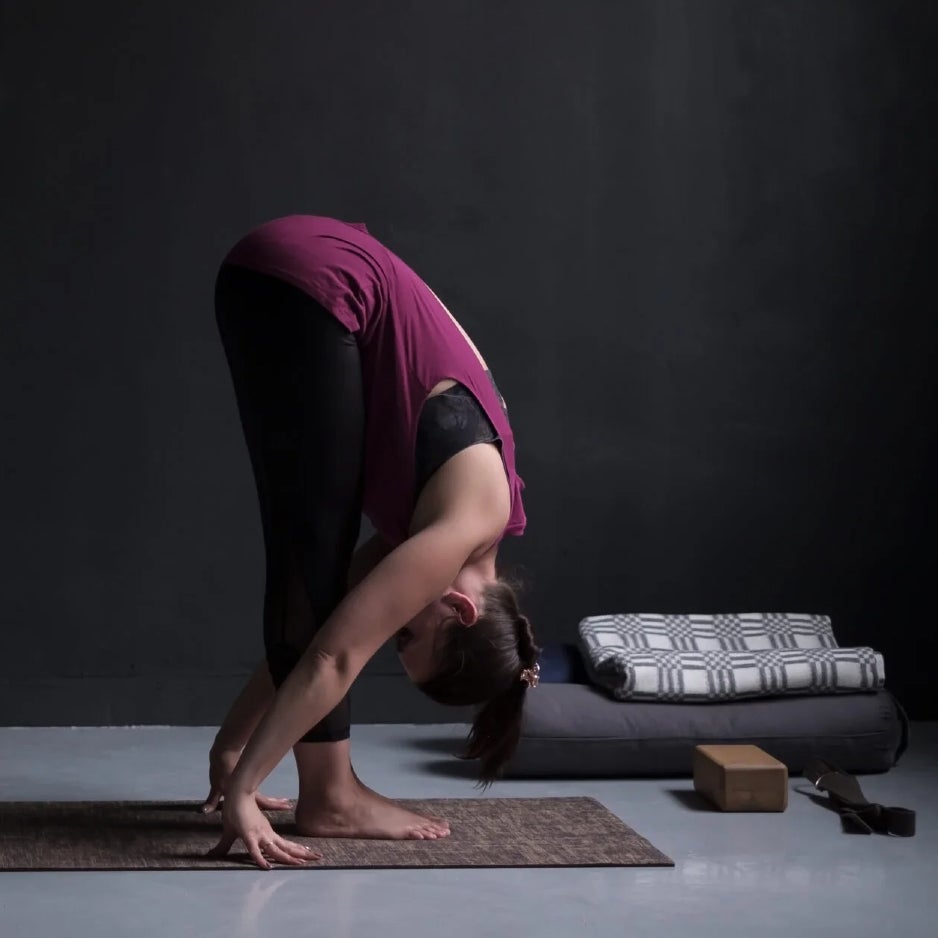It’s late. You’re tired yet tense. You want to relax but you find yourself tossing and turning and becoming more frustrated and less in the mood for rest. That’s exactly when you need yoga for sleep.
What Type of Yoga Works Well for Sleep?
There’s no single style or sequence of yoga that’s ideal for preparing everyone to rest. It’s more the manner in which you approach yoga for sleep that makes a difference. Sustained and gentle stretches. Slow and steady breathing. Moving at a measured pace rather than rushing.
It’s a simple equation of easy movement and relaxed breathing that enables you to find profound release and relaxation—both physical and psychological—which is exactly what research shows, again and again, to facilitate falling asleep. Studies also indicate that practicing yoga for sleep can not only help you fall asleep, but can improve the
The poses that follow can be practiced in their entirety and in the order in which they appear, which will take a little less than 30 minutes. Or you can simply turn to a handful of the poses. Whichever poses you select, don’t neglect to take your final resting pose, Savasana. It is the culmination of the previous poses and is your true precursor to sleep.
15 Ways to Practice Yoga for Sleep
Props that will help: locks (or stacks of books), blanket, and bolster (or a couple bed pillows stacked on top of one another)
Practice Tips: Breathe with long, full, deep inhalations and exhalations
Warm-up: Begin in (Child’s Pose) for 1 minute (10–15 breaths)

1. Utthan Pristhasana (Lizard Pose)
From (Downward-Facing Dog Pose), bring your left foot forward between your hands and lower your right knee to the floor. Walk your left foot to the outer edge of your mat and place your elbows or forearms on a block or the floor. Remain here for 1 minute or 10-15 breaths. Repeat on the second side.

2. Salabhasana (Locust Pose)��
Lower yourself and come to lying on your belly with your feet about hip-distance apart. If you prefer extra cushioning, place a folded blanket beneath your hips. Clasp your hands behind your back or, if you have tight shoulders, bend your elbows and lift your arms toward your ears. Exhale and press the tops of your feet into the floor. Inhale as you lift your chest and arms into . Gaze forward and slightly down. Remain here for 1 minute or 10-15 breaths. Release your hands beneath your shoulders, inhale, and push yourself up to hands and knees. Exhale as you push back to Downward-Facing Dog.

3. Uttanasana (Standing Forward Bend)��
Stand with your feet hip-width apart or a little wider, bring a slight bend to your knees, and hinge at your hips to fold forward in . Loosely hold opposite elbows, keeping a relaxed grip, or let your hands rest alongside your feet. Exhale and lengthen through your back, allowing your neck and shoulders to relax and your head to lower toward the mat. Remain here for 1 minute or 10-15 breaths. Release your hands to the mat, press down through your feet, inhale, and slowly rise to standing.

4. Prasarita Padottanasana (Wide-Legged Standing Forward Bend)
Stand and turn to face the long side of your mat. Step your feet wide apart with your toes angled slightly inward. Inhale and lift your chest. Exhale and slowly fold forward from your hips, resting your fingertips on the mat beneath your shoulders in If you prefer a more active stretch for your upper body, take reverse prayer hands behind your back. If you prefer a more restful pose, rest the top of your head on a block or a stack of books to help release tension in your neck and shoulders. Remain here for 10-15 breaths or 1 minute. To come out of the pose, press down through your feet, inhale, and slowly rise to standing.
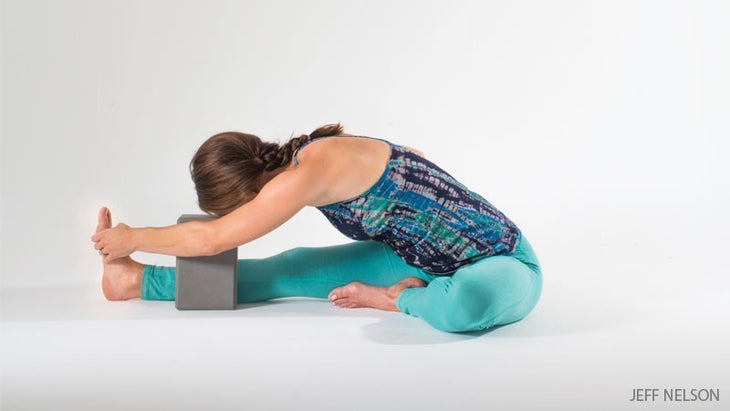
)��
Come to a seat on your mat with your legs extended straight in front of you. Bring the bottom of your left foot against your�� inner right thigh and place your right hand by your hip. Lift your left arm, exhale, and slowly fold over your right leg, reaching for your foot or shin. If you prefer, rest your forehead on a block. Remain here for 1 minute or 10-15 breaths. Switch sides.

| 1 minute
Sit tall on the edge of a folded blanket with your legs extended. Exhale and stretch your spine long as you fold forward. Keeping your spine lengthened, hold onto your feet or shins, with your elbows bent and arms relaxed. Rest your forehead on a block. Remain for 10–15 breaths.

| 2 minutes
From a seated position, place a bolster at the base of your sacrum and place a folded blanket on it toward the far end. Bend your knees and bring the bottoms of your feet together. Lie back on your bolster and rest your head on the blanket to give it just enough lift so your head is above your heart. Relax your legs, shoulders, and neck. Remain here for 10–15 breaths. Using your hands, bring your knees together and then slowly roll off the bolster onto one side. Keep your bolster and blanket setup.
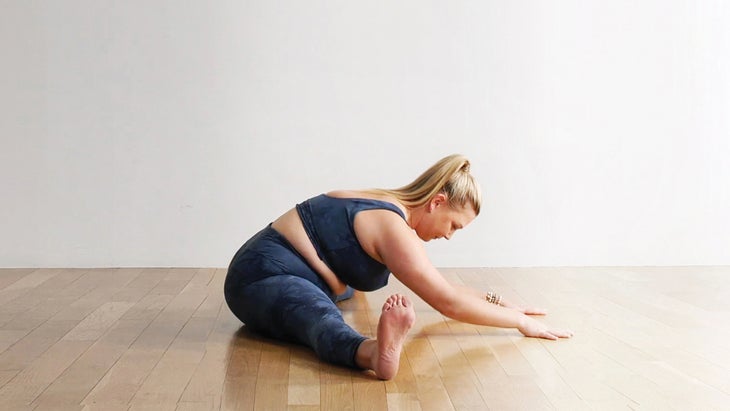
8. Parsva Upavistha Konasana (Side Seated Wide Angle Pose)
Slowly come to a seated position with your legs spread wide. Place a block on the inside of your right calf. Inhale and lengthen your spine. Exhale, lean forward, and gently twist your chest over your right leg, resting your fingertips or hands on the mat and letting your forehead rest on the block. Remain here for 5 breaths. Inhale and slowly lift your chest. Repeat on the other side.

If you have low back tightness or pain or if you have any tenderness in your knees, skip this pose. Otherwise, come to sit on your heels. To make this pose even more restorative, place a bolster or a couple of bed pillows stacked atop one another against the base of your sacrum. Bring your ankles a little wider than your hips and sit between them. If you feel any discomfort, bring your knees as wide as your hips. If that doesn’t bring relief, skip this pose. Slowly recline onto your forearms and then all the way onto your back, with your arms alongside your ears, or rest your back against the bolster with your arms extended alongside your body. Remain here for about 3 minutes. Bring your hands alongside your bolster and slowly press yourself back up to seated. Shift your weight onto your right hip and bring your left leg in front of you.��
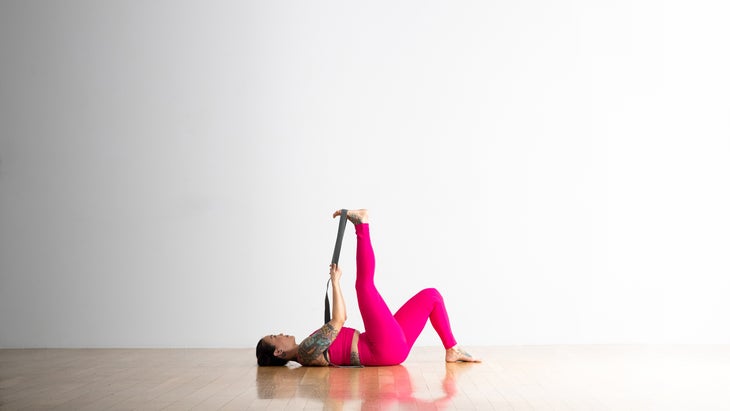
Lie on your back with your legs extended. Bend your left knee and bring your foot on the mat. Inhale and bring your right leg vertical, clasping the back of your thigh with your hands or using a strap, towel, or sweatshirt around your thigh or the arch of your foot to support your leg. Push your thigh against your hands or your foot against the strap until you feel a stretch but not a strain. Remain for 5-10 breaths or about 1 minute. Switch sides.

��
Start by lying on your back. Bend your knees and place your feet hip-width apart directly beneath your knees. Inhale and lift your pelvis. Place a block under your sacrum (the flat, triangle-shape bone in your lower back) and release your weight onto the block. The block should feel comfortable and supportive; if it does not, lift your hips off the block and readjust it. You can have your block on any side; only turn on the tallest edge if your back feels extremely relaxed and comfortable. Open your arms onto the floor in a cactus shape, then lift your heart. Remain here for 10-15 breaths or 1 minute. Inhale and lift your hips enough so that you can easily slide the block off to the side. Slowly lower yourself and allow your low back to sink to the mat.
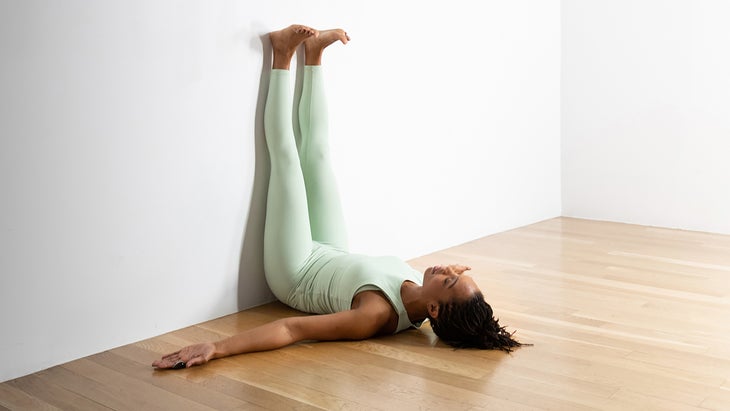
��
Sit close to the wall, with one hip touching it, and bring your hands slightly behind your hips. Bend your elbows and slowly lean back as you simultaneously lower your back to the floor and sweep your legs up the wall. Bring your buttocks as close to the wall as possible. Let your legs relax into the wall, keeping a slight bend in your knees if your hamstrings are tight. Rest with your arms by your sides or in cactus arms, palms up. (If you prefer a little more cushioning beneath your spine, first fold a blanket lengthwise into a narrow stack that’s the length of your spine. As you sit close to the wall, place the blanket behind you, perpendicular to the wall, and lie back onto the blanket as you sweep your legs up the wall.) You may find yourself falling asleep, making this truly yoga for sleep. Remain for 30-45 breaths or at least 3 minutes.

13. Siddhasana, variation (Adept’s Pose, variation)
Sit tall on a blanket and cross your ankles. Inhale and lift your spine, and exhale as you take your left hand to your outer right knee. Place your right hand on the floor behind you for support. Inhale and lengthen; exhale and gently twist deeper. Remain for 10–15 breaths. Switch sides.
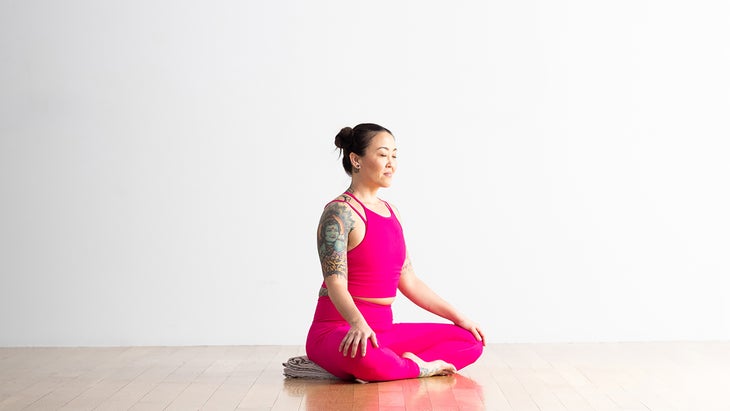
14. Sukhasana (Easy Pose)��
Sit with your legs crossed. Close your eyes and tune into the rhythm of your breath. Become aware of your heartbeat. Inhale and lengthen your spine; exhale and ground down through your seat. Rest your hands on your knees. Stay here for 3 minutes.
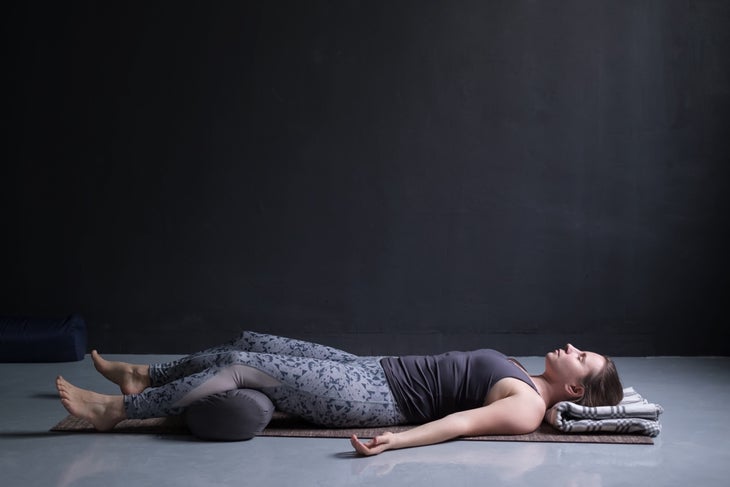
15. Savasana (Corpse Pose)
Lie on your back with your legs relaxing at least hip-distance apart and arms resting at your sides, palms up. If you prefer, bring a bolster or a couple pillows beneath your knees to relieve tension in your low back and place a folded blanket beneath your head for comfort. Let the weight of your body sink into your mat and let your attention rest on your breath. Take a long, slow exhale. Stay here for at least 4 minutes and as long as long as you like. You may prefer to take Savasana in bed—chances are you will find it to be, quite literally, yoga for sleep.



